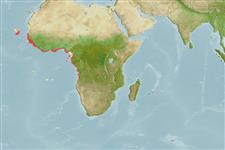Environment: milieu / climate zone / depth range / distribution range
Ecologia
marinhas; estuarina demersal; intervalo de profundidade 5 - 200 m (Ref. 7345), usually 5 - 40 m (Ref. 27115). Tropical; 20°C - 25°C (Ref. 27115); 31°N - 15°S, 27°W - 14°E
Eastern Atlantic: from the coasts of Morocco to Angola (Ref. 3149); including Cape Verde archipelagos and the Canaries. Also recorded from southern Spain, Tunisia, Algeria, Israel and Greece (Ref. 112505).
Tamanho / Peso / Idade
Maturity: Lm ? range ? - ? cm
Max length : 45.0 cm SL macho/indeterminado; (Ref. 3148); common length : 38.0 cm SL macho/indeterminado; (Ref. 3148)
Descrição suscinta
Chaves de identificação | Morfologia | Morfometria
Espinhos dorsais (total) : 9; Raios dorsais (total) : 24 - 26; Espinhos anais: 6; Raios anais : 24 - 26. Caudal peduncle spine surrounded by a bright orange-yellow spot.
Coastal species found in the mouth of rivers and lagoons (Ref. 7345). Found on rocky and coral bottoms (Ref. 2683). Feeds on zooplankton, phytoplankton and detritus (Ref. 28587). Minimum depth reported from Ref. 27115.
Ciclo de vida ou comportamento de acasalamento
Maturities | Reprodução | Spawnings | Egg(s) | Fecundities | Larvas
Desoutter, M., 1990. Acanthuridae. p. 962-964. In J.C. Quero, J.C. Hureau, C. Karrer, A. Post and L. Saldanha (eds.) Check-list of the fishes of the eastern tropical Atlantic (CLOFETA). JNICT, Lisbon; SEI, Paris; and UNESCO, Paris. Vol. 2. (Ref. 7345)
Status na Lista Vermelha da UICN (Ref. 130435)
Ameaça para os humanos
Harmless
Uso pelos humanos
Pescarias: pouco comercial; Aquário: Espécies comerciais
Ferramentas
Relatórios especiais
Baixar XML
Fontes da internet
Estimates based on models
Preferred temperature (Ref.
123201): 21.9 - 28, mean 26.5 °C (based on 118 cells).
Índice de diversidade filogenética (Ref.
82804): PD
50 = 0.5000 [Uniqueness, from 0.5 = low to 2.0 = high].
Bayesian length-weight: a=0.02188 (0.01279 - 0.03743), b=2.95 (2.81 - 3.09), in cm total length, based on LWR estimates for this species & Genus-body shape (Ref.
93245).
Nível Trófico (Ref.
69278): 2.5 ±0.24 se; based on food items.
Resiliência (Ref.
120179): médio(a), tempo mínimo de duplicação da população 1,4 - 4,4 anos (Preliminary K or Fecundity.).
Fishing Vulnerability (Ref.
59153): Moderate vulnerability (42 of 100).
Climate Vulnerability (Ref.
125649): High to very high vulnerability (75 of 100).
Nutrients (Ref.
124155): Calcium = 111 [44, 405] mg/100g; Iron = 1.13 [0.44, 3.00] mg/100g; Protein = 17.7 [16.7, 18.8] %; Omega3 = 0.208 [0.090, 0.472] g/100g; Selenium = 36.1 [11.5, 135.0] μg/100g; VitaminA = 10.3 [3.2, 30.8] μg/100g; Zinc = 2.57 [0.84, 5.10] mg/100g (wet weight);
